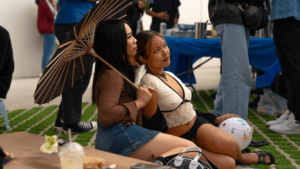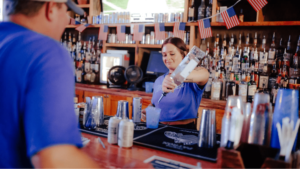The Los Angeles Zoo and Botanical Gardens attracts more than 1.5 million daily visitors each year. This number is even more impressive when you consider that the zoo is in a huge city packed with options for things to do.
So what’s their secret strategy for drawing crowds, year after year?
Special events. These year-round events fuel attendance growth, drive patron loyalty, and bring the zoo incremental revenue.
We sat down with Kait Hilliard, VP of marketing and communications, to learn how the L.A. Zoo continues to find new and exciting ways to market its venue. Here are her tips for making the most out of your space for events so you can continue to grow your organization:
Tip 1: Give people time-sensitive reasons to visit
Like most zoos, the L.A. Zoo experiences a dip in attendance in the winter. To attract more people, they use seasonal holidays to motivate attendance. In 2014, the zoo hosted its first L.A. Zoo Lights, a concept also adopted by several other major zoos across the country. The event spanned the entire month of December and transformed the entire park into a dazzling nighttime winter wonderland.
Over 170,000 attendees came to see the spectacle, 70% above the zoo’s goal. How? Online ticketing helped expand the zoo’s reach to new audiences and encourage ticket buyers to commit early. In fact, the zoo was able to sell 70% of their event tickets in online presales, allowing them to reach extraordinary attendance levels for a first-year event.
In addition to L.A. Zoo Lights, the zoo hosts a variety of other successful events — both in conjunction with daytime operations and as special nighttime experiences. Many of these nighttime events are anchored around holidays, major dates, and cultural celebrations shared across the nation. For example, during African-American History Month, the L.A. Zoo produces a weekend of programming that includes live music, dance performances, and artist-facilitated crafts.
“Events drive attendance by creating a sense of urgency and generating PR,” Hilliard says. “While people can come to the zoo year-round, events make them want to come tomorrow. They can serve as an insurance policy against things like bad weather by drawing attendance even in the off-season.”
Tip 2: Center special events around themes to attract different audiences
The general admission audience of the zoo is primarily families with children, so the L.A. Zoo targets their daytime events (included in the price of entry) to attract more of them. But nighttime events are an opportunity to attract a whole new audience: millennials. Zoos across the nation are increasingly branching out into new types of events that attract millennials — from 5Ks to wine tastings.
According to Hilliard, the trick is to know your market. In L.A., there are thousands of beer festivals. So when the L.A. Zoo decided to host its “Brew at the Zoo,” they knew they had to differentiate their offering. Given that most beer fests take place in parking lots or similarly unremarkable settings, Hilliard’s marketing and PR efforts emphasized the “wildly” unique location of the L.A. Zoo, with its lush grounds and opportunities for animal encounters. The 2014 event was a huge hit, selling out with 4,000 attendees and 42 breweries present.
The success of Brew at the Zoo and other nighttime events means that “we’re reintroducing people to the zoo who haven’t been since they were 10 years old,” says Hilliard. “The key is for the experience to be unique, social, and relevant to them.”
Tip 3: Use your venue to attract site rentals
Site rentals are a great added-revenue stream for zoos. The L.A. Zoo rents out different spaces for birthday parties, corporate events, and other celebrations — and offers lots of add-ons for organizers. From DJs to gourmet catering, the zoo offers everything an event organizer could dream of in a location. They’re currently working on a new event space to host weddings and large corporate gatherings. During the 236 nights of L.A. Zoo Lights, the zoo also hosted 18 private parties which let attendees explore the light displays after they finished dinner.
“The zoo has something no other venue can offer,” says Hilliard. “Where else can you go and have a 113-acre park with wild animals in it as the backdrop to your special event? It makes it really easy for the host—they don’t have to dress up the location. The guests come for the party and then stay for the zoo.”
Tip 4: Take the time to incorporate sponsors for added value
Another great way to add excitement and drive incremental revenue? Incorporate tie-ins with partners and sponsors in your events.
Zoos have a unique appeal to sponsors because they’re so family-friendly and fairly inexpensive to access. The L.A. Zoo has found their demographic closely mirrors that of the greater Los Angeles area. so they can work with sponsors who are interested reaching, for example, middle and lower income households and the Hispanic population in a very targeted way.
The zoo is constantly coming up with new, creative sponsorship opportunities. At their July “Family Jam” event, Southern California Honda Dealers handed out coupons for fountain drinks and rides on the carousel. Their Halloween “Boo at the Zoo” event was sponsored by the 99 Cents Only Stores, who provided candy and branded trick-or-treat bags. The zoo also partners with a local children’s hospital to sponsor their play park and other special events.
As Hilliard explains, the zoo is “a great sponsorship fit for brands that want to reach a family audience and drive home their commitment to conservation and social responsibility. Not only do sponsorships generate revenue, they also bring an added layer of fun that enhances the guest experience and makes the event even more memorable.”
To learn more about how you can continue to scale your events every year, check out “4 Ways to Accelerate Event Growth With Technology.”





